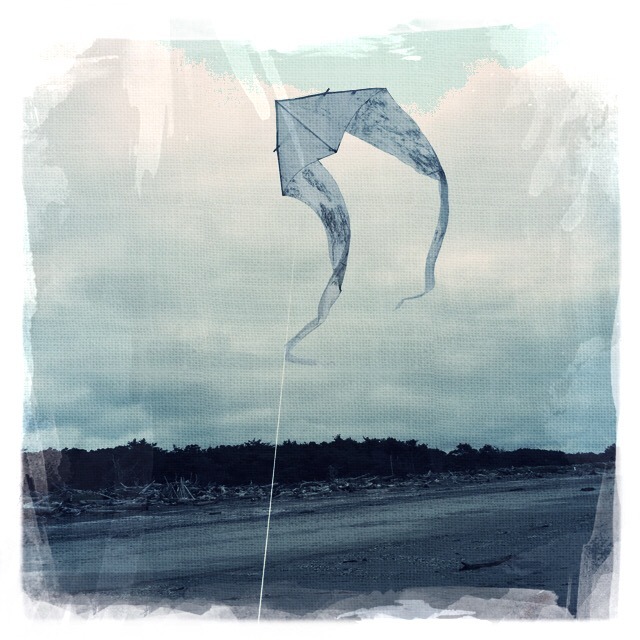Well, this, for example: do you or do you not own art? Why would anyone say “I put no energy into my physical appearance?” Really? You don’t wear clothes? You’re disdaining choices?
I am fascinated by the passionate responses to Deleuze and Guattari – the refusal to read them, even while discussing their concepts; the wondering of how far one can go with a metaphor (that they say is not a metaphor) of the rhizome?
I’ve been flying kites. Thinking of lines of flight. Walking beaches, sitting by campfires, even singing a Janis Joplin song in the dark of the woods. Thinking of maps and tracings. Drawing pictures. Trying some dowsing. Thinking of rupture. Thinking about 1000 Plateaus, dipping in here and there, dipping into people who are writing about it with such clarity (or not). Thinking about Whitman:
Allons! to that which is endless, as it was beginningless,
To undergo much, tramps of days, rests of nights,
To merge all in the travel they tend to, and the days and nights they tend to,
Again to merge them in the start of superior journeys;
To see nothing anywhere but what you may reach it and pass it,
To conceive no time, however distant, but what you may reach it and pass it,
To look up or down no road but it stretches and waits for you—however long, but it stretches and waits for you;
To see no being, not God’s or any, but you also go thither,
To see no possession but you may possess it—enjoying all without labor or purchase—abstracting the feast, yet not abstracting one particle of it…
All in all I have had and am having a wonderful time. Occasionally in my readings I come across some student who is obviously taking a class in D & G and trying to write a sensible response to something about them and I feel rather badly… Like Whitman, I don’t think they really work as subjects in the classroom or, rather, in most classrooms.
Which makes me think, yet again, of how I don’t much like classrooms and about how I keep ending up in the same places with the whole education thing… it has not served those I care about well, and those who provide the service are, for the most part, not considering who is marginalised and being left out.
So the question of the week is whether or not the #rhizo15 rhizome is invasive. First, I think this lamentably defines the rhizomatic in one way – some rhizomes, botanically, are certainly invasive. As are some plants that propagate by seeds or spores or… the difference between those kinds of propagation and rhizomatic propagation is, I think, that with rhizomes – horizontal stems that grow shoots – they can pop up anywhere, theoretically, and one doesn’t see them coming. The capacity for rupture.
However, there are many kinds of rhizomatic plants that are not at all invasive – which actually need to be cosseted and provided for in really specific ways. The very breath of roughness destroys them. This interests me more – and the ways in which the ideas of rhizomatic investigations and a nomadology approach can honour the less powerful. D & G point out the powerful, overarching aborescent cultural forces that can so quickly and decisively damage any of us, but particularly those who were less likely to be heard in the first place. There are lots of critics of the “science” of Deleuze and Guattari (again, what is it that compels such passionate responses?) but we know that they were aware of such plants in their specificity:
The orchid deterritorializes (γ) by forming an image, a tracing of a wasp; but the wasp reterritorializes on that image. The wasp is nevertheless deterritorialized, becoming a piece in the orchid’s reproductive apparatus. But it reterritorializes the orchid by transporting its pollen. Wasp and orchid, as heterogeneous elements, form a rhizome. It could be said that the orchid imitates the wasp, reproducing the image in a signifying fashion (mimesis, mimicry, lure, etc.). But this is true only on the level of the strata — a parallelism between two strata such that a plant organization on one imitates an animal organization on the other. At the same time, something else entirely is going on: not imitation at all but a capture of code, surplus value of code, an increase in valence, a veritable becoming, a becoming-wasp of the orchid and a becoming-orchid of the wasp.
And I return to Whitman:
Now I see the secret of the making of the best persons,
It is to grow in the open air, and to eat and sleep with the earth.
Here a great personal deed has room;
A great deed seizes upon the hearts of the whole race of men,
Its effusion of strength and will overwhelms law, and mocks all authority and all argument against it.
Here is the test of wisdom;
Wisdom is not finally tested in schools;
Wisdom cannot be pass’d from one having it, to another not having it;
Wisdom is of the Soul, is not susceptible of proof, is its own proof,
Applies to all stages and objects and qualities, and is content,
Is the certainty of the reality and immortality of things, and the excellence of things;
Something there is in the float of the sight of things that provokes it out of the Soul.
Now I reëxamine philosophies and religions,
They may prove well in lecture-rooms, yet not prove at all under the spacious clouds, and along the landscape and flowing currents.
Here is realization;
Here is a man tallied—he realizes here what he has in him;
The past, the future, majesty, love—if they are vacant of you, you are vacant of them.
Only the kernel of every object nourishes;
Where is he who tears off the husks for you and me?
Where is he that undoes stratagems and envelopes for you and me?Now I see the secret of the making of the best persons,
It is to grow in the open air, and to eat and sleep with the earth.
Here a great personal deed has room
A great deed seizes upon the hearts of the whole race of men,
Its effusion of strength and will overwhelms law, and mocks all authority and all argument against it.




Ha Lots of questions in your blog. I did read D&G and they do not speak to me, but that is not what i want to write about. In my humble opinion the question of this week also should be read as: Are participants in this course called #rhizo15 invasive? Do they invite new humans into the crowd? Are they forming an in-group and being exclusive? Is rhizo15 still an open place for learning?
And how do we avoid this invasive in-group behaviour in classes, schools, groups?
Yes Jaap you are right, i should have spoke to that. it was a concern last year that there were off-putting cliques that were not inclusive of everyone, and not inclusive of new-comers. many people were coming together after having been together in other courses. i didn’t feel this at all. for me, the issue was just keeping up with technology and understanding some of the concepts, and my sense was that this was also the issue for others. I felt like people were saying “I feel left out” when what they meant was “How come I, too, can’t keep up?” however, it is also interesting that there’s been way more effort this year, from Dave and others, to continue “welcoming” and meeting new folks by commenting and tweeting back etc.. there have also been good clear discussions about methodologies – how to surf all the posts, how to congregate – I think these have been helpful (thanks Sarah!). But there’s also this undercurrent of D & G as being too hard, too silly – which I suppose itself creates a community of a kind? This has been interesting for me because I keep seeing similar intentions on building community lost in schools and organizations, as people defer to the perception of curriculum and purpose. i like the idea of clarifying how do we “avoid this invasive in-group behaviour in classes, schools, groups?” I am writing as part of my thesis on the voiced perception of segregation by people who have experienced it and an interesting thing is that although great expense and care is put into changing “programs” if people feel they are not part of the choices about where to go together and who to be with, they continue to feel as segregated and excluded as they did in institutional settings – they use the same imagery and metaphors to voice their concerns. so one possible extrapolation of my research is that schools could be more focused on building inclusive community as a priority – that might be the first question for them. what might happen?
I’ve just ignored this week’s topic. I’m following this advice instead:
Be the Pink Panther and your loves will be like the wasp and the orchid, the cat and the baboon.
Now have that music as an ear worm 😉
Love your kite. Missed you over the last few days.
the daleks will never win 🙂
Daleks – now that’s an invasive species!
lovely read as usual A 😉 I reluctantly wrote something in the end, but I should have been doing my marking yesterday, and now I’m going to be up all night tonight! very wise to ignore it S !
i always look forward to your posts – sorry you’ll be up all night but i’m glad 🙂
Beautiful post Aaron. “The very breath of roughness destroys them.” Pure poetry.
It’s funny actually. There was a wasp in the house a few days ago. I was able to catch it and release it (as I do with most bugs in the house if I can) but I told my friend maybe I should kill it because it is not a pollinator. I didn’t kill it. About an hour later I was on the Internet and still thinking about that wasp. I don’t know how – maybe I googled “wasp pollinator” or saw someone else’s rhizo post but that whole thing about the orchid and wasp came up. I learned a lot from that experience.
yes – and the wasp thing – the idea of crossing from insect to flower and that one might be a little of each – gets more fully fleshed in the ideas of cyber-tech people that one direction of D & G studies go into… like Rosi Braidotti’s post-human writings.
Enjoyed reading this. I am researching into ways of using art as a catalyst to inspire ‘stuck’ learners. That is people whose horizons have been reduced by the mechanistic, instructional courses they have required to do in the past. Was really interested in the idea that some people ‘dont know’ whether they have got art works at home. Its begs so many questions – are we scared to call something ‘art’ ? Who has the right to name things as art?
yes… “i’m not sure if it’s art” “i put no thought into my appearance” – what, as Maron Sapon Shevin says, is our investment in handing over and/or avoiding discernment and a way of belonging. i did a session at a conference last year with Maron and some other folks called “creating the perfect storm” after spending a few days with her the year before, singing and dancing (while i was mostly drawing but by the end i was singing and dancing and drawing) – the idea was that art could be used to bring people to a point where they felt they had to speak, assert themselves, make decisions. it turned (rhizomatically) into something interesting with the arrival of two wiccans, who brought their experience of rituals and prayers that were about connecting with the elements to create intention. Diana Masny’s work on multiple literacy theory and rhizoanalysis is another way into this idea of what gets named as literacy (or art or…) and the wonderful Maxine Greene….
Should schools, or parents or whoever, teach how to enter a crowd or an (in)group and persevere into making contacts?
Should students know better how to use technology and communication skills to hold on when trying to be part of a movement or a class or a group?
I like it when Juergen Habermas tells it it all about communication, you know.